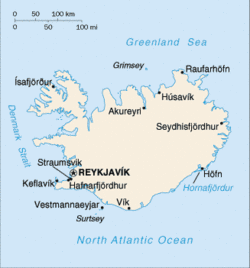Welcome to the Virtual Education Wiki ~ Open Education Wiki
Iceland
by Paul Bacsich for Re.ViCa. Minor update for VISCED by Ann Fastré
For entities in Icelandsee Category:Iceland
Partners situated in Iceland
None.
Iceland in a nutshell
The Republic of Iceland (Icelandic: Ísland or Lýðveldið Ísland (names of Iceland), is an island country located in the North Atlantic Ocean. It has a population of about 320,000 and a total area of 103,000 km².[3] Its capital and largest city is Reykjavík.
Located on the Mid-Atlantic Ridge, Iceland is volcanically and geologically active on a large scale; this defines the landscape. The interior mainly consists of a plateau characterized by sand fields, mountains and glaciers, while many big glacial rivers flow to the sea through the lowlands. Warmed by the Gulf Stream, Iceland has a temperate climate relative to its latitude and provides a habitable environment and nature.
According to tradition recorded in Landnámabók, the settlement of Iceland began in 874 when the Norwegian chieftain Ingólfur Arnarson became the first permanent Norwegian settler on the island. Others had visited the island earlier and stayed over winter. Over the next centuries, people of Nordic origin settled in Iceland. Until the 20th century, the Icelandic population relied on fisheries and agriculture, and was from 1262 to 1918 a part of the Norwegian, and later the Danish monarchies. In the 20th century, Iceland's economy and welfare system developed quickly. In recent decades, Iceland has implemented free trade in the European Economic Area and diversified from fishing to new economic fields in services, finance and various industries.
Today, Iceland has some of the world's highest levels of economic and civil freedoms. In 2007, Iceland was ranked as the most developed country in the world by the United Nations' Human Development Index. It was also the fourth most productive country per capita, and one of the most egalitarian, as rated by the Gini coefficient. Icelanders have a rich culture and heritage, such as cuisine and poetry and the medieval Icelandic Sagas are internationally renowned. Iceland is a member of the UN, NATO, EFTA, EEA and OECD. Iceland is the sole partner of the Faroe Islands signatory to the Hoyvík Agreement.
Iceland has been especially badly affected by the current world financial crisis. The nation's ongoing economic crisis has caused significant unrest and made Iceland the first western country to borrow from the International Monetary Fund since 1976.
Iceland education policy
Schools in Iceland
(sourced from http://en.wikipedia.org/wiki/Iceland)
The Ministry of Education, Science and Culture is responsible for the policies and methods that schools must use, and they issue the National Curriculum Guidelines. However, the playschools and the primary and lower secondary schools are funded and administered by the municipalities.
Nursery school or leikskóli, is non-compulsory education for children younger than six years, and is the first step in the education system. The current legislation concerning playschools was passed in 1994. They are also responsible for ensuring that the curriculum is suitable so as to make the transition into compulsory education as easy as possible.
Compulsory education, or grunnskóli, comprises primary and lower secondary education, which often is conducted at the same institution. Education is mandatory by law for children aged from 6 to 16 years. The school year lasts nine months, and begins between 21 August and 1 September, ending between 31 May and 10 June. The minimum number of school days was once 170, but after a new teachers' wage contract, it increased to 180. Lessons take place five days a week. The Programme for International Student Assessment, coordinated by the OECD, currently ranks the Icelandic secondary education as the 27th in the world, significantly below the OECD average.
Upper secondary education or framhaldsskóli follows lower secondary education. These schools are also known as gymnasia in English. It is not compulsory, but everyone who has had a compulsory education has the right to upper secondary education. This stage of education is governed by the Upper Secondary School Act of 1996. All schools in Iceland are mixed sex schools.
Higher education
Universities in Iceland
The University of Iceland (Icelandic: Háskóli Íslands) is an Icelandic state university, founded in 1911. During its first year of operation 45 students were enrolled. Today, the university provides instruction for about 13,650 students studying in eleven faculties.
There is also the Iceland University of Education.
Polytechnics in Iceland
Education reform
The Bologna Process
(very important for European countries)
Administration and finance
Quality assurance
Information society
Iceland is a very technologically advanced society. By 1999, 82.3% of Icelanders had access to a computer. Iceland also had 1,007 mobile phone subscriptions per 1,000 people in 2006, the 16th highest in the world.
Towards the information society
Information society strategy
ICT in education initiatives
Interesting Virtual Campus Initiatives
Interesting Programmes
There is a distance learning programme at the Iceland University of Education - see http://mennta.hi.is/vefir/ust/tjona/volvunet.ppt
Re.ViCa Case-study
Lessons learnt
References
- Eurydice National system overview on education systems in Europe, August 2011
- Eurybase, The Information Database on Education Systems in Europe: The Education System in Iceland, 2009/10
For OER policies and projects in Iceland see Iceland/OER
